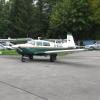Gents,
I would recommend to ignore the subtle difference between IAS and CAS completely... - there is a place for it but not during approach, with usually shifting winds, gusts and all the other nice effects of low altitude turbulences...
What is much more important is to understand the effect of weight (or mass) on the required approach speed of our birds!
At full MTOW (which will never happen because we burn fuel during roll-up and take-off) the full flap stall speed of a M20F is 62 mph! Fine! Never try to fly THAT slow during an approach at MTOW though... - common sense.
However, when the tanks are almost empty and we fly alone the total weight goes down a lot and all of a sudden the stall speed goes down as well... - and with my Mooney it is now just 53 mph!!! Multiplied by 1.3 is still just 69 mph! This is a huge difference to MTOW speeds!
I invite you to try it out... - based on total weight of your plane, the fuel onboard (as little as comfortable) and your individual "gross weight" your M20F should stall somewhere between 51 and 55 mph!
The runway of my home airfield is a comfortable 2.000ft long and when I stick to my weight & balance calculations (including the stall speed based on todays weight), I have no problems to vacate the runway at the 1/2 marker with minimum fuel, I do not even have to brake hard. This would be impossible though, if I always flew the same approach speed as if at MTWO.


![]()


